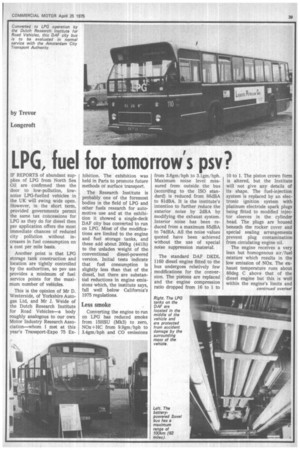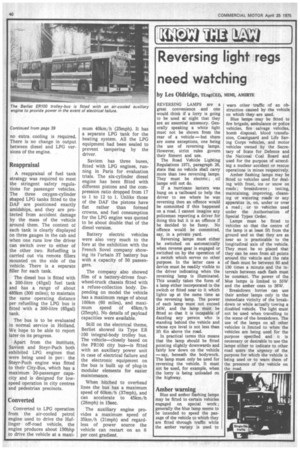LPG, fuel for tomorrow's psv?
Page 41

Page 42

If you've noticed an error in this article please click here to report it so we can fix it.
IF REPORTS of abundant supplies of LPG from North Sea Oil are confirmed then the door to low-pollution, lownoise LPG-fuelled vehicles in the UK will swing wide open. However, in the short term, provided governments permit the same tax concessions for LPG as they do for diesel then psv application offers the most immediate chances of reduced city pollution without increases in fuel consumption on a cost per mile basis.
Another point is that LPG storage tank construction and location are tightly controlled by the authorities, so psv use provides a minimum of fuel service points for the maximum number of vehicles.
This is the opinion of Mr D. Westerside, of Yorkshire Autogas Ltd, and Mr J. Weide of the Dutch Research Institute for Road Vehicles—a body roughly analogous to our own Motor Industry Research Association—whom I met at this year's Transport-Expo 75 Ex hibition. The exhibition was held in Paris to promote future methods of surface transport.
The Research Institute is probably one of the foremost bodies in the field of LPG and other fuels research for automotive use and at the exhibition it showed a single-deck DAF city bus converted to run on LPG. Most of the modifications are limited to the engine and fuel storage tanks, and these add about 200kg (4411b) to the unladen weight of the conventional diesel-powered version. Initial tests indicate that fuel consumption is slightly less than that of the diesel, but there are substantial reductions in engine emissions which, the institute says, fall well below California's 1975 regulations.
Less smoke
Converting the engine to run on LPG has reduced smoke from 15HSU (Mk3) to zero, NOx+HC from 9.9gm/hph to 3.4gm/hph and CO emissions from 3.8gm/hph to 3.1gm/hph. Maximum noise level measured from outside the bus (according to the ISO standard) is reduced from 88dBA to 81dBA. It is •the institute's intention to further reduce the exterior noise by 2dBA by modifying the exhaust system. Interior noise has been reduced from a maximum 85dBA to 74dBA. All the noise values quoted have been achieved without the use of special noise suppression material.
The standard DAF DKDL 1160 diesel engine fitted to the bus undergoes relatively few modifications for the conversion. The pistons are replaced and the engine compression ratio dropped from 16 to 1 to 10 to 1. The piston crown form is altered, but the Institute will not give any details of its shape. The fuel-injection system is replaced by an electronic ignition system with platinum electrode spark plugs being fitted to modified injector sleeves in the cylinder head. The plugs are housed beneath the rocker cover and special sealing arrangements prevent plug contamination from circulating engine oil.
The engine receives a very lean but homogenous air/fuel mixture which results in the low emission of NOx. The exhaust temperature runs about 80deg C above that of the diesel engine but this is well within the engine's limits and no extra cooling is required. There is no change in output between diesel and LPG versions of the engine.
Reappraisal
A reappraisal of fuel tank strategy was required to meet the stringent safety regulations for passenger vehicles. The three oxygen-cylinder shaped LPG tanks fitted to the DAF are positioned exactly amidships, and they are protected from accident damage by the mass of the vehicle around them. The content of each tank is clearly displayed on three gauges in the cab and when one runs low the driver can switch over to either of the other two. Refuelling is carried out via remote fillers mounted on the side of the vehicle. There is a separate filler for each tank.
The diesel bus is fitted with a 200-litre (45ga1) fuel tank and has a range of about 485km (300 miles); to maintain the same operating distance per refuelling the LPG bus is fitted with a 300-litre (65gal) tank.
The bus is to be evaluated in normal service in Holland. We hope to be able to report later on its progress.
Apart from the institute, Saviem and Steyr-Puch both exhibited LPG engines that were being used in psv: the Steyr-Puch engine was fitted to their City-Bus, which has a maximum 20-passenger capacity and is designed for lowspeed operation in city centres and pedestrian precincts.
Converted
Converted to LPG operation from the air-cooled petrol engine used to drive the Haflinger off-road vehicle, the engine produces about 150bhp to drive the vehicle at a maxi mum 40kmjh (25mph). It has a separate LPG 'tank for the heating system. All the LPG equipment had been sealed to prevent tampering by the driver.
Saviem has three buses, fitted with LPG engines, running in Paris for evaluation trials. The six-cylinder diesel engine has been fitted with different pistons and the compression ratio dropped from 17 to 1 to 12 to 1. Unlike those of the DAF the pistons have flat rather than formed crowns, and fuel consumption for the LPG engine was quoted to be about double that of the diesel version.
Battery electric vehicles were also very much to the fore at the exhibition with the French Sovel company showing its l'urbain 3T battery bus with a capacity of 50 passengers.
The company also showed film of a battery-driven fourwheel-truck chassis fitted with a refuse-collection body. Depending on model the vehicle has a maximum range of about 100km (60 miles), and maximum speed of 45km/h (25mph). No details of payload capacities were available.
Still on the electrical theme, Berliet showed its Type ER 100 integral-body trolley bus. The vehicle—closely based on the PR100 city bus—is fitted with an auxiliary power unit in case of electrical failure and the electronic equipment on the bus is built up of plug-in modular elements for easier maintenance.
When hitched to overhead lines the bus has a maximum speed of 60km/h (37mph), and can accelerate to 45km/h (28mph) in 15sec.
The auxiliary engine provides a maximum speed of 35km/h (21mph) and regardless of power source the vehicle can restart on an 8 per cent gradient.




















































































